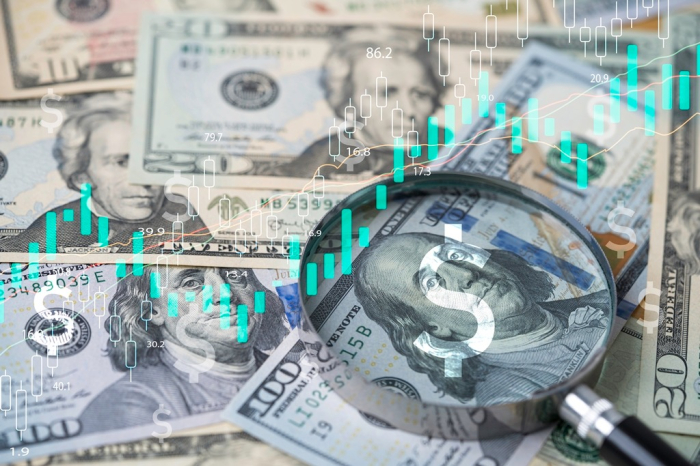In today’s article, we will discuss the ratio of AAA bond yields to Treasury bill yields.
AAA Bond Vs. T-Bill
Again, this ratio tries to understand the relationships among interest rates, real growth, and inflation. The key is that inflation affects long-term interest rates much more strongly than short-term rates. Historically, the wider the difference between the two rates, the better stocks have performed.
The best proxy for short-term rates is the Treasury bill; the best proxy for long-term rates is AAA-rated corporate bonds maturing in twenty years or more.
To figure the ratio, simply find the current yield on twenty-year AAA bonds and divide by the current rate paid by ninety-day Treasury bills. For example, if AAA bonds yield 9% and T-bills yield 5%, the ratio is 1.80 to 1.
A great rule of thumb is to buy stocks when the ratio is above 1.20 and sell when it dips below 1.10.
This strategy has worked well because the Federal Reserve tends to lower short-term rates when the economy is growing slowly or not at all to stimulate growth. Meanwhile, long-term rates tend to remain high due to fear of inflation.
At this point in the cycle, inflation is whipped. The potential for faster economic growth with no inflation is high; stocks can take off to new highs. Bond investors believe inflation is down for the count as the economy revives. Consequently, the gap between short—and long-term rates narrows, and stocks’ potential gains shrink.
Finally, the gap between short—and long-term interest rates narrows to the point where our ratio falls below 1.1. At that point, economic growth has probably peaked, and deflation begins to threaten. Stocks plummet.
Why is it curtains for stocks when short-term rates edge over long-term rates? Once again, it goes back to the question of whether or not economic growth is sustainable. As I said above, long-term interest rates essentially represent businesses’ demand for long-term loans, which they use to finance expansion, i.e., to build plants, hire workers, enlarge distribution lines, etc.
Businesses usually borrow with as big a payback period as possible to ensure their investments have enough time to turn profitable. Usually, short-term loans just don’t cut. Businesses only borrow long-term at high rates if they expect to grow considerably between now and when the loans are due. The more growth businesses are expected, the higher long-term rates will be. So, long-term rates reflect expectations of growth: real growth plus inflation.
Short-term interest rates, however, are driven by expectations for inflation between now and the loan’s due date. If long-term interest rates are much higher than short-term ones, companies expect their earnings to grow considerably after inflation is considered. So, it’s also a sign that stocks are the place to be.
The ratio of AAA-bond yields to Treasury bill yields doesn’t have a perfect record. For example, when deflation is in force, the ratio can be positive even while stocks plummet. That’s what happened during the Great Depression.
But this ratio is about as close to perfection as any interest rate indicator. Following it alone will often be to your financial advantage.

How Investors Can Use Interest Rates To Trade Stocks
The two inflation-based interest rate indicators described above- “real” interest rates and the AAA-bond/T-bill yield ratio- best use interest rates to trade stocks. You can beat the market by following either or both of them.
But remember that even though they both take inflation into account, their record in forecasting stock prices could be better than the record for commodity prices.
Although interest rates are an essential piece of the economic puzzle, they fall last among my strategy’s other basic building blocks: inflation, unemployment, money supply, and price-to-earnings ratios. And remember, interest rates are only effective in forecasting stocks to the degree that they reflect the trend in inflation.
The critical variable affecting stocks is inflation, not interest rates. Following interest rates can exclusively present a misleading picture of stocks’ future. Stocks may buck up or down in response to interest rate swings in the short term as traders attempt to jockey for advantage. But don’t make the mistake of believing that an interest rate swing always precedes an equal and opposite reaction in stocks.
Changes in rates usually correspond to changes in inflation, but only sometimes. Only if they do correspond will stocks rise or fall. Interest rates do not affect stocks on their own.
As good as the guidelines we have outlined are, you’ll still do far better if you use them with the other indicators we have mentioned in many of our educational articles for investors.
Final Thoughts…
- Interest rates are poor predictors of stock market trends unless they are considered “real” interest rates in the context of inflation.
- “Real” or inflation-adjusted interest rates are best expressed as the yield on twenty-year AAA-rated corporate bonds minus the twelve-month rate of change in the All Commodity Producer Price Index. The higher “real” interest rates are, the more bullish stocks are.
- The higher the difference between long-term interest rates (twenty-year AAA bond yields) and short-term interest rates (three-month Treasury bill yields), the more bullish stocks are.
Get In Touch
Leeb Capital Management offers no-obligation consultations with an investment professional.


